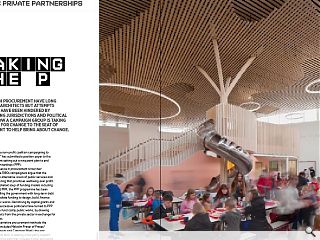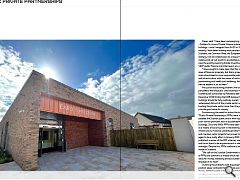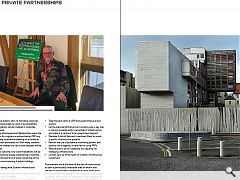Public Private Partnerships: Taking the P
25 Apr 2023
Issues with procurement have long exercised architects but attempts at reform have been hindered by overlapping jurisdictions and political inertia. Now a campaign group is taking their zeal for change to the seat of government to help bring about change.
Jubilee Scotland, a non-profit coalition campaigning to end “debt slavery” has submitted a position paper to the Scottish Parliament setting out a nine point plan to end public-private partnerships (PPP).
A regular presence in procurement since their introduction in the 1990s campaigners argue that the time is right for an alternative vision of public services and infrastructure funding that prioritises wellbeing over profit. Birthing an alphabet soup of funding models including PFI, NPD, Hub and MIM, the PPP programme has been criticised for saddling the government with long-term debt in return for immediate funding to design, build, finance and operate public works.
Hamstrung by capital grants and borrowing limits successive politicians have turned to PPP as the only way to fund costly public works, by drawing upfront capital costs from the private sector in exchange for long-term liabilities. Setting out alternative procurement methods the grouping, (which includes Malcolm Fraser of Fraser/Livingstone Architects and Common Weal), the pro-independence think tank, is seeking cross-party support for a nine-point action plan that includes higher borrowing limits. Fraser said: “I have been campaigning against PPP – Scotland’s ruinous Private Finance policies for public buildings – since I resigned from A+DS in 2006. Most recently I have been working with partners at Jubilee Scotland, the Common Weal, the European Services Strategy Unit and statisticians to critique the current malaise and set out a path to prudential public funding that uses the existing Learning Estate Investment Programme ‘LEIP’ public finance and other levers as a route forward.”
“I have sought to make clear that this is not just an issue of financial propriety, but that a proper public route should lead to more responsible public buildings and infrastructure, with the issues of carbon, retrofit, placemaking and health and wellbeing, that architects are natural leaders in, at its heart.” Not just an accounting problem, the issue has percolated into the public consciousness with a Jubilee Scotland poll conducted by Panelbase between 12-16 December 2022 finding that 62% believe that public buildings should be fully publicaly owned. This mirrors widespread distrust of the private sector with only 16% trusting the private sector more than the public sector to provide good value for money.
Summarising the need for action the task force wrote: “Public-Private Partnerships (PPPs) have, in all their forms, saddled the Scottish public sector with high levels of debt, poor service provision, lack of accountability, and unsafe buildings. Since the 1990s PPPs have been championed as a means of securing new or maintaining existing infrastructure. However, enlisting private finance to build and maintain public projects has proven time and time again to be a costly affair. In January 2020 Audit Scotland published a review of the PPP schemes used in Scotland and found them to be expensive and in need of more oversight. Despite this, PPPs continue to be a preferred model in Scotland.
“We call on the Scottish Government to abolish the use of PPPs and commit to a model which has safety, quality, value for money, wellbeing and accountability to the taxpayer at its heart.”
Outlining the problems with the present system the position paper contends that PPPs are poor value for money, tantamount to a ‘misuse’ of public finances and saddling local councils with ever-growing debt. Adding to the problem is the fact that contracts are ‘extremely difficult’ to renegotiate, leaving no viable exit strategies once agreed to. The authors warn of dwindling resources year after year, compounded by a lack of accountability as the precise obligations remain cloaked in corporate confidentiality clauses. New leadership at Holyrood and Westminster opens the door to change but for a system as entrenched as PPP, any movement is as likely to resemble steering an oil tanker as the short, sharp shock advocated for. With many concerns circulating since the nineties the risk is more decades will be lost to prevarication.
To forestall this outcome nine recommendations will be put before future working groups, establishing a roadmap for reaching the promised land of public ownership of the procurement and commissioning of public buildings:
- Let public well-being drive Scottish infrastructure investment
- Do not allow the Mutual Investment Model (MIM) to be put into active use in Scotland
- Act on the recommendations from Audit Scotland’s review of the PPP scheme
- Take the best parts of LEIP and expand these across sectors
- Let the planned Infrastructure Company play a key role in moving towards public ownership of infrastructure and make it a centre of local government support
- Mandate Scottish National Investment Bank to invest in public infrastructure projects
- Rethink the use of prudential borrowing powers and address the budgetary incentives for using PPPs
- Rebuild public sector capability and capacity for managing infrastructure
- Let Net Zero be at the heart of Scottish infrastructure investment
Procurement sits at the base of the tree of construction, as both a particularly intractable area of reform also the key to solving many societal ills at once; from good governance and well-being to fiscal discipline and carbon reduction. Who knows, we may end up with a generation of schools, hospitals and other public buildings we can be proud of.
|
|





